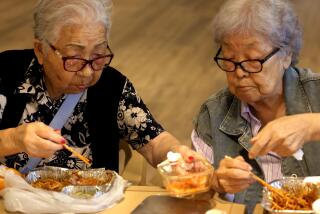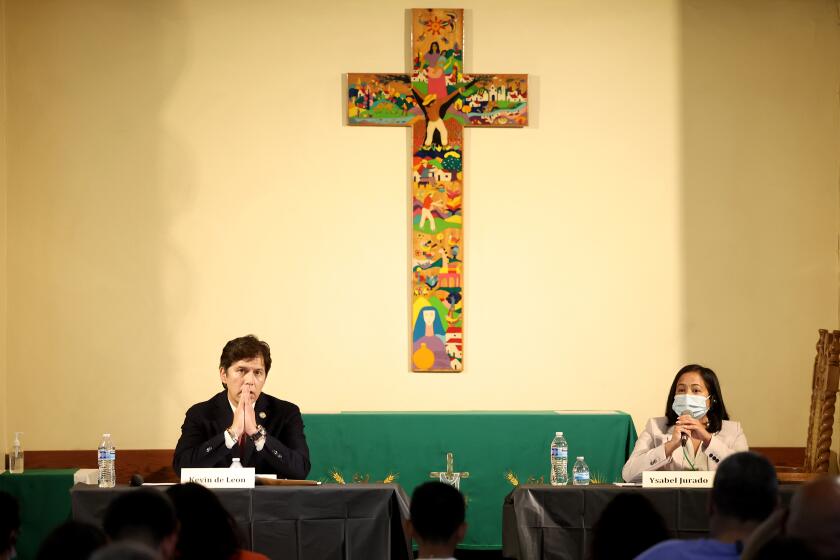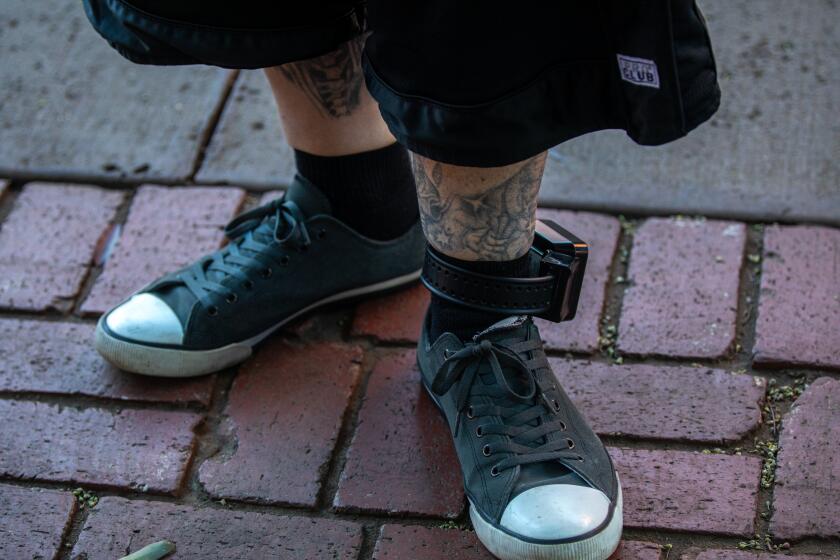Eastside Sushi? Sí
For years, after he had moved back to the old neighborhood, Roy Yoshioka jogged past a slender little restaurant on 1st Street in Boyle Heights. He couldn’t imagine it was still open, the place his uncle and aunt had opened more than half a century ago.
The place where he watched his mother make sushi for thousands of bento lunch boxes.
Then, a few months ago, an old friend invited him to lunch there -- at the last Japanese restaurant in Boyle Heights. The bar-like wooden counter was still there, and so were the stools. The three booths still had the same cushioned red backrests.
“It was like stepping into history, like stepping back into the 1950s,” said Yoshioka, 65. “It was the first time I had come back here since the ‘60s. I thought it would have been gone a long time ago. I was amazed everything was pretty much the same.”
Outside, much had changed.
For much of its history, Boyle Heights was a place diverse waves of immigrants called home. Russians, Armenians, Greeks and Italians all settled in this neighborhood just east of downtown Los Angeles.
Cesar Chavez Avenue was then Brooklyn Avenue, home of the original Canter’s deli and the hub of the largest Jewish community west of Chicago.
Today, Boyle Heights is predominantly Latino. Most of the other ethnic groups that once settled in the neighborhood have disappeared. But not the Japanese.
They arrived in the 1920s. Most are gone; the 2000 U.S. Census counted about 600 Japanese Americans there. But the Japanese have left markers.
There are the prominent Tenrikyo Temple, Nanka Printing and Hayashi Realty on 1st Street. A little farther east, also on 1st Street, is Haru Florist, still favored by Japanese Americans from as far away as Victorville who stop to visit their loved ones at Evergreen Cemetery.
And the little Japanese restaurant, which remains much as it was. Once evidence of 1st Street’s role as a Little Tokyo East, the restaurant now serves a mostly Mexican clientele.
On a recent day, Henry and Dolores Padilla, 82 and 80, walked into the restaurant.
Padilla had been a shoeshine boy in Little Tokyo in the 1930s. Many of his classmates at Roosevelt High School were Japanese American, and he recalled how they were taken to internment camps after the Japanese attack on Pearl Harbor in 1941.
One of his friends wanted to serve in the Army, but there was such a cloud of suspicion cast on Japanese Americans that he had some trouble. Henry Padilla wrote a letter to the government, attesting to the good character of his friend, but he doesn’t know whether it helped.
Henry joined the Army and in 1944 shipped off to Europe, where he fought in the Battle of the Bulge. When he returned, his sons joined Japanese American Boy Scout troops, and he later became a Scoutmaster.
For nearly 50 years, the Padillas went, alone or with their family, to the restaurant, even as the faces of Boyle Heights changed.
--
‘It was pretty busy’
The restaurant has had three owners.
In 1956, Yoshioka’s uncle and aunt, Mr. and Mrs. Seto, opened Otomi Cafe. Yoshioka said he doesn’t even remember their first names, but he knows they had a lot of business then.
During the weekends, Japanese people from the neighborhood and throughout L.A. would have prefectural meetings during picnics at places like Griffith Park and Elysian Park. The restaurant would make bento box lunches, hundreds of them, for the meetings.
“The majority of patrons were still Japanese Americans,” said the Rev. Alfred Tsuyuki, the friend who invited Yoshioka there for lunch. “In the old days, it was pretty busy. So you’d see people sitting inside or standing outside waiting to get in.”
The Setos owned Otomi Cafe until the early 1970s, when they sold it to a Mr. and Mrs. Seino, who changed the name to Otomisan.
Some of the customers reflect the diversity that had once defined Boyle Heights.
Nadine Diaz, 44, grew up in Boyle Heights, the daughter of a Mexican American man and a Japanese American woman who were, like Yoshioka and Tsuyuki, Roosevelt High School graduates.
In 1972, Diaz moved to Salt Lake City with her parents while her father went to medical school. But she returned in 1984 to care for her ailing grandfather, Antonio Diaz. He loved to eat at Otomisan. The restaurant reminds her of lunches with him, she said.
But it also reminds her of her Japanese grandfather, who, to her knowledge, never stepped into Otomisan, though he lived not far away on Chicago Street. He was a chef, and if he wanted Japanese food, he cooked it.
“Now that he’s gone, I come here more or less to feel those connections,” she said during lunch there recently. “This place looks the same. It feels the same. It feels happy. And I really like to see Mexicans eating here. It shows an open-mindedness to another culture.”
The restaurant still bears many of the touches added during the 1970s and ‘80s, she said. There’s the black-and-white picture of Sylvester Stallone standing next to a bald Japanese stuntman. Another picture shows the same stuntman with a Teenage Mutant Ninja Turtle. An engraved Japanese doll hangs over an old mirror over the lunch counter.
By then a major demographic shift was well under way . More and more, the customers were reflecting Boyle Heights’ emergence as a Mexican American neighborhood.
Today, many of the remaining Japanese are immigrants from that country, and they live on nearby streets like Michigan, Pennsylvania and Fickett. Most of them are women, and many of them are widows.
If they want to eat Japanese food, they mostly cook for themselves or take a bus to Little Tokyo. And if they do eat at a local establishment, it isn’t for the Japanese food.
Hiroko Kobayashi said she used to eat at Otomisan but has not done so for a few years. Instead, like many other Japanese who live in Boyle Heights, she eats at one of the local taco stands or at El Tepeyac on Evergreen Avenue, known for its enormous Manuel’s Special burrito.
Eating the burrito once provoked her to use some of the Spanish she has learned.
“I see the burrito. Big!” she exclaimed. “I say, ‘Geez, that’s like a perro!’ ” using the Spanish word for dog.
Haru Yamasaki, 82, was born in Boyle Heights and has lived most of her life on Mathews Street, just a block from the restaurant. She doesn’t go as often as she used to, but she said her 4-year-old grandson likes to eat the eel and white rice there.
“He likes to eat his rice in a special way. He puts water in there and eats it with a spoon,” Yamasaki said with a chuckle.
--
Sad interlude
Many people stopped going to Otomisan after Seino died two years ago and the restaurant was closed for six months. He wasn’t just the owner, he was also the sole cook. Henry Padilla said he “did everything, cooking and everything. He was the nicest guy you’d ever meet.”
And when he died, his widow closed the place.
“She couldn’t handle it, I guess,” Padilla said. “I truly didn’t think it would open again.”
But the owner of a dry-cleaner on 4th and Fresno streets, Yayoi Watanabe, 55, did not want that to happen. Over 15 years, Watanabe had become used to her largely Latino clientele and knew that many of them had patronized Otomisan.
She talked to the widow and convinced her to sell the restaurant to her.
“I know Mexican customers from dry-cleaning,” Watanabe said recently, wearing a red T-shirt proclaiming “Everybody Loves Mushrooms.” “They are very friendly, Mexican people. I wanted to keep Japanese food for them.”
She said she has been rewarded with gratitude and last year, Councilman Jose Huizar recognized the restaurant for its longevity.
“The customers say ‘Thank you. I’m so happy,’ ” Watanabe said.
But it’s been tough, she said.
Even after the restaurant reopened in 2005, the damage was done. Many people passed by, seemingly unaware that it was open. Watanabe said some customers walked in and told her they had just realized they could eat there, even though they only lived around the block.
Yoshioka said that had his friend not asked him to lunch there earlier this year, he might have kept jogging past, vaguely thinking the old restaurant was closed.
For a while, cook Yukishige Hamada made bento box lunches and walked around Boyle Heights, asking people if they wanted to buy Japanese food.
Slowly, some customers returned.
Hamada said he likes cooking real Japanese food for a community that otherwise might not get to try it. He keeps old recipes from the cook before him, who had made notes on customers’ suggestions for ingredients.
Like his predecessor, the 59-year-old Hamada occupies the tiny curtained kitchen alone.
He also upholds another tradition simply by living in Boyle Heights. Hamada lives just a block away, near Soto Street. In a strange way, he said, it reminds him of Japan.
“I was raised in a small town, with my grandfather and grandmother, playing with neighborhood kids, where everyone knew each other,” Hamada said. “This place gives me a feeling of the small town I lived in as a young child.”
--
More to Read
Sign up for Essential California
The most important California stories and recommendations in your inbox every morning.
You may occasionally receive promotional content from the Los Angeles Times.











